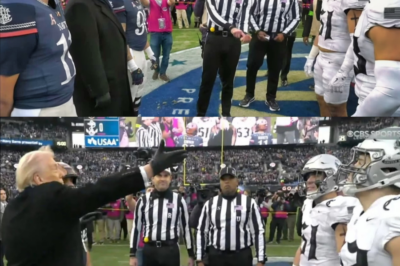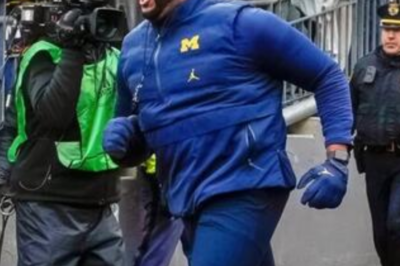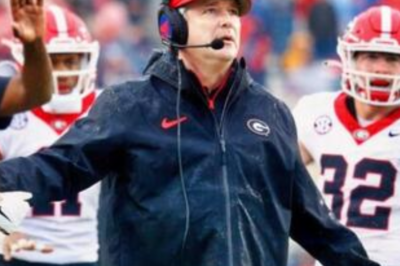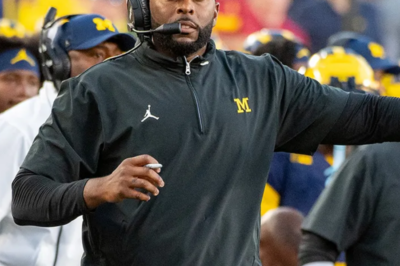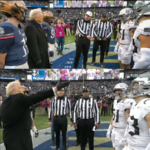VIDEO: The Digital Frenzy Unpacked. How a Moment Between Vanderbilt Fans Electrified the Internet and Sparked a Cultural Conversation
It was a fleeting, unscripted moment, the kind that television producers and directors pray for to inject a burst of spontaneous life into a broadcast.
In the vast, sprawling landscape of live sports, where countless hours of coverage are dedicated to analyzing plays, strategizing over formations, and debating athlete performance, it is often the human moments happening just outside the lines of play that capture the collective imagination with the most potent force.
Such was the case on a seemingly ordinary game day, when the camera, in its relentless search for reaction and emotion, panned across the stands and settled on a group of fans cheering for the Vanderbilt University Commodores.
What transpired in the seconds that followed would ignite a digital firestorm, propelling these individuals from anonymous spectators to the central figures of an online frenzy.
The phrase “for obvious reasons,” appended to countless social media posts and article headlines, became a cryptic yet universally understood shorthand for the event.
But to dismiss this viral phenomenon as a simple story of aesthetics or fleeting internet fame would be to miss a far richer, more complex narrative.
This is not just an account of a video going viral; it is a case study in the mechanics of modern digital culture, the power of visual media, the double-edged sword of virality, and the enduring human fascination with beauty, context, and story.
This deep dive seeks to unpack every layer of this event, from the initial broadcast frame to its lasting cultural footprint, exploring the how, the why, and the so-what of a moment that truly made the entire internet “go crazy.”
The Genesis: Deconstructing the Moment on Live TV
To understand the scale of the reaction, one must first appreciate the context of the moment itself.
Live sports broadcasts are a meticulously choreographed ballet of multiple camera angles, director cues, and on-the-fly editorial decisions.
The primary focus is, rightly, on the athletes and the game. However, a crucial secondary element is capturing the atmosphere of the stadium—the tension, the jubilation, the despair of the fans.
These “crowd shots” serve to connect the home viewer to the emotional core of the event.
It was during one such routine cutaway that the camera operator landed on a group of fans, later identified as students of Vanderbilt University.
They were engaged in the universal ritual of fandom: cheering, laughing, and embodying the hopeful spirit of supporters whose team was in the thick of the action.
There was nothing particularly extraordinary about their behavior; they were simply being fans.
However, their presentation—their appearance, their evident camaraderie, and their photogenic qualities—immediately stood out to the viewing audience.
The exact details of their attire—whether they wore Vanderbilt black and gold, or more casual game-day outfits—became a point of discussion.
Their expressions, a mix of focused excitement and genuine enjoyment, were perfectly framed. In the parlance of television production, it was a “good shot.”
It was clean, well-composed, and conveyed the intended emotion. But for the millions watching at home, and more importantly, for the thousands who were simultaneously engaging on social media platforms, it was more than just a good shot. It was a captivating image.
The term “for obvious reasons” began to trend almost instantaneously. This phrase is a fascinating piece of internet lexicon.
It operates on a premise of shared understanding, eliminating the need for explicit description. It suggests that the reason for the video’s appeal is so self-evident that to elaborate would be redundant.
In this case, it was a polite, if not slightly cheeky, acknowledgment that the fans in question were considered exceptionally attractive by conventional standards.
This shared, unspoken agreement became the engine of the clip’s initial spread. Users on Twitter, TikTok, and Instagram would share the clip with this simple caption, trusting that their followers would immediately comprehend the subtext.
The video clip, often trimmed to a perfectly loopable few seconds, began to escape the confines of sports commentary and seep into the broader digital ecosystem.
It was no longer just a moment from a Vanderbilt game; it was a viral piece of content in its own right.
The Engine of Virality: How Social Media Platforms Amplified a Fleeting Moment

A single moment on television, no matter how striking, does not become a global phenomenon without a powerful distribution network.
The architecture of contemporary social media platforms is specifically designed to facilitate and accelerate this very process. The viral journey of the “Vanderbilt fans” clip is a textbook example of this digital amplification.
The Role of the “Clip Account”:
In the modern media diet, dedicated social media accounts exist solely to identify and share the most engaging moments from live television.
These accounts, with massive followings on platforms like X (formerly Twitter) and Instagram, act as cultural curators.
They are staffed by individuals who monitor multiple broadcasts simultaneously, ready to capture, edit, and post any moment of humor, drama, or unusual interest.
The moment the Vanderbilt fans appeared on screen, it is almost certain that numerous such accounts identified its potential. Their posts, often with captions like “The camera finds some Vanderbilt fans,” or simply “👀,” served as the primary ignition point.
The Algorithmic Boost:
Once these initial posts were live, the sophisticated algorithms governing platforms like TikTok and Instagram began their work.
These algorithms prioritize content that generates high levels of “engagement”—a metric comprising likes, comments, shares, and, crucially, watch time.
The video of the fans, being visually striking and easily digestible, naturally accrued these metrics at an explosive rate. Users didn’t just watch it once; they re-watched it.
They shared it with friends with a simple “Wow.” They commented with fire emojis (🔥) and other symbols of approval. This surge in positive engagement signaled to the platform that this was “high-quality” content, worthy of being pushed onto more and more users’ “For You” pages and feeds, creating a positive feedback loop of visibility.
The Memification and Community Engagement:
As the clip spread, it ceased to be a passive video to be watched and became a active template for community participation. This is a key phase in any viral event.
On TikTok, users employed the clip in “duets,” reacting to the reaction. On Twitter, users created side-by-side comparisons, joking about how this moment was the biggest “win” for Vanderbilt athletics all season.
Memes were generated, overlaying text that humorously articulated what every viewer was supposedly thinking. This participatory culture transformed the clip from a piece of content into an interactive experience, solidifying its place in the internet’s daily conversation.
The Mainstream Media Pivot:
The final stage of amplification occurs when traditional media outlets, which initially broadcast the moment, take notice of the online chatter. News websites, sports blogs, and even entertainment portals began publishing articles with headlines strikingly similar to the one that inspired this very piece:
“The Internet Is Going Crazy Over These Vanderbilt Fans.” These articles, while often simply documenting the phenomenon, lend it a veneer of legitimacy and extend its reach to audiences who may not be as deeply embedded in social media circles. They complete the cycle, turning an online trend into a recognized “news story.”
Beyond the “Obvious Reasons”: A Deeper Cultural Analysis
While the initial wave of attention was undeniably fueled by the fans’ appearance, the longevity and depth of the conversation surrounding the event invite a more nuanced analysis. To label it as purely superficial is to ignore the complex cultural undercurrents it brought to the surface.
The Sociology of Fandom and Representation: For decades, the portrayal of the “ideal sports fan” in popular media has often been a narrow one, frequently leaning towards male-centric stereotypes. The viral celebration of these female Vanderbilt fans, who were both passionate about their team and visually prominent, challenges this trope.
It sparked discussions about the growing presence and influence of women in sports spaces, not just as spectators but as knowledgeable, engaged enthusiasts. The conversation evolved from “look at these fans” to “look at these fans and what their visibility represents.”
The fundamental question surrounding any viral sensation is: what happens when the buzz dies down? The lifespan of an internet trend is notoriously short. However, the digital footprint is permanent.
For the individuals involved, life likely returned to a semblance of normalcy, but with a crucial difference: they now possess a unique and personal connection to a shared cultural memory. They may have gained a modest following on social media, and their names will forever be tied to this event in search results. How they choose to navigate this—whether by embracing their moment of fame, speaking out about the experience, or deliberately retreating from the public eye—becomes their own personal story.
For the Vanderbilt community, the moment becomes a piece of modern folklore—a fun, shared anecdote about the time their university briefly became the center of the internet universe. It’s a story that will be retold by students and alumni for years to come.
For the broader digital culture, the phenomenon serves as another data point in the ongoing study of virality. It reinforces understood principles: the power of visual media, the speed of platform amplification, and the human appetite for shared experiences centered around relatable, human moments. It provides a template that will be replicated, in one form or another, in countless future viral events.
More Than a Moment
The viral explosion surrounding the Vanderbilt fans on live TV was, on its surface, a simple story of a camera finding attractive people in a crowd.
But to leave the analysis there is to do a disservice to the intricate tapestry of technology, sociology, and human psychology that it represents. It was a perfect storm—a visually compelling moment, captured live, and unleashed upon a digital ecosystem perfectly engineered to make it a global talking point.
It forced conversations about fandom, representation, privacy, and objectification. It demonstrated the awesome power of social media algorithms to shape our collective attention. And, at its heart, it was a reminder that in an age of highly produced, sanitized content, we are still drawn most powerfully to authentic, unscripted humanity.
The “obvious reasons” were merely the entry point; the true reasons for the internet’s fascination were as deep and varied as the internet itself. The clip was not just a video; it was a mirror, reflecting back at us our own values, our desires, and the complex ways we connect in the digital age.
News
SHOCKING LIE UNCOVERED: Diego Pavia’s deception isn’t just a scandal—it’s a revelation that threatens to EXPOSE the entire 2025 Heisman race as a fraud. What are they hiding?
SHOCKING LIE UNCOVERED: Diego Pavia’s deception isn’t just a scandal—it’s a revelation that threatens to EXPOSE the entire 2025 Heisman race as…
VIDEO: Trump’s single coin flip changes EVERYTHING. What happened next will leave you speechless.
VIDEO: Trump’s single coin flip changes EVERYTHING. What happened next will leave you speechless. In the annals of American political…
SHOCK MOVE: Sherrone Moore Just DROPPED A BOMB on Social Media… And It’s About to IGNITE The Rivalry.
SHOCK MOVE: Sherrone Moore Just DROPPED A BOMB on Social Media… And It’s About to IGNITE The Rivalry. In the…
BREAKING: 2 Georgia Stars Arrested in Shocking Pre-Playoff Incident—Will It Derail Their Championship Run?
BREAKING: 2 Georgia Stars Arrested in Shocking Pre-Playoff Incident—Will It Derail Their Championship Run? In a shocking turn of events…
SHOCKING: Film Star Claims This Photo Shows Sherrone Moore’s SECRET During Michigan’s Biggest Game. You Won’t BELIEVE What He Was Really Doing.
SHOCKING: Film Star Claims This Photo Shows Sherrone Moore’s SECRET During Michigan’s Biggest Game. You Won’t BELIEVE What He Was…
SHOCKING: Michigan makes urgent employment decision involving Sherrone Moore’s personal life. You won’t BELIEVE the details.
SHOCKING: Michigan makes urgent employment decision involving Sherrone Moore’s personal life. You won’t BELIEVE the details. In the world of college…
End of content
No more pages to load

![The Entire Internet Is Going Crazy Over Female Vanderbilt Fans Who Went Viral On Live TV For Obvious Reasons [VIDEO] - NewsBreak](https://img.particlenews.com/image.php?type=thumbnail_580x000&url=2IiHTo_15nzhoI300)

